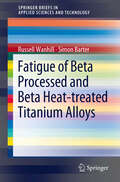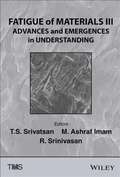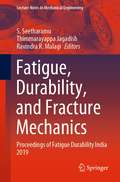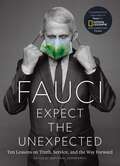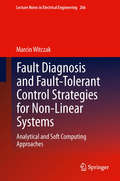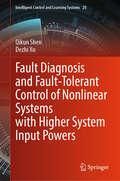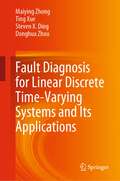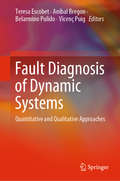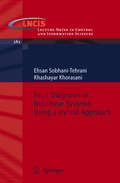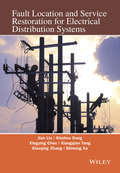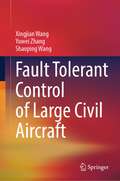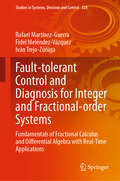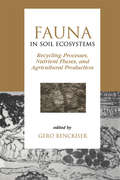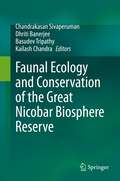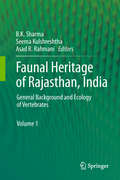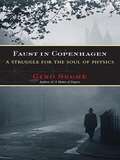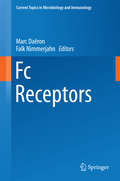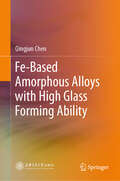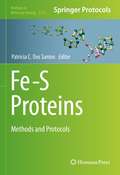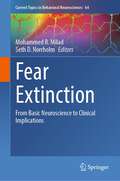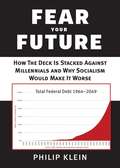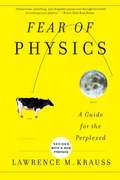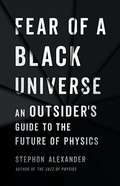- Table View
- List View
Fatigue of Beta Processed and Beta Heat-treated Titanium Alloys
by Simon Barter Russell WanhillThis publication reviews most of the available literature on the fatigue properties of β annealed Ti-6Al-4V and titanium alloys with similar microstructures. The focus is on β processed and β heat-treated alloys because β annealed Ti-6Al-4V has been selected for highly loaded and fatigue-critical structures, including the main wing-carry-through bulkheads and vertical tail stubs, of advanced high-performance military aircraft. An important aspect of the review is a concise survey of fatigue life assessment methods and the required types of fatigue data. This survey provides the background to recommendations for further research, especially on the fatigue behaviour of β annealed Ti-6Al-4V under realistic fatigue load histories, including the essential topic of short/small fatigue crack growth. Such research is required for independent fatigue life assessments that conform to the aircraft manufacturer's design requirements, and also for life reassessments that most probably will have to be made during the service life of the aircraft.
Fatigue of Materials
by S. SureshWritten by a leading researcher in the field, this revised and updated second edition of a highly successful book provides an authoritative, comprehensive and unified treatment of the mechanics and micromechanisms of fatigue in metals, non-metals and composites. The author discusses the principles of cyclic deformation, crack initiation and crack growth by fatigue, covering both microscopic and continuum aspects. The book begins with discussions of cyclic deformation and fatigue crack initiation in monocrystalline and polycrystalline ductile alloys as well as in brittle and semi-/non-crystalline solids. Total life and damage-tolerant approaches are then introduced in metals, non-metals and composites followed by more advanced topics. The book includes an extensive bibliography and a problem set for each chapter, together with worked-out example problems and case studies. This will be an important reference for anyone studying fracture and fatigue in materials science and engineering, mechanical, civil, nuclear and aerospace engineering, and biomechanics.
Fatigue of Materials III: Advances and Emergences in Understanding
by T. S. Srivatsan Raghavan Srinivasan M. Ashraf ImamThis volume contains papers presented in the third international symposium titled Fatigue of Materials: Advances and Emergences in Understanding held during the Materials Science and Technology 2014 meeting in Pittsburgh, Pennsylvania, USA, in October 2014. The book contains contributions from engineers, technologists, and scientists from academia, research laboratories, and industries. The 19 papers are divided into five topical areas: Session 1: Aluminum Alloys Session 2: Ferrous Materials I Session 3: Ferrous Materials II Session 4: Composite Materials Session 5: Advanced Materials Session 6: Modeling The papers cover a broad spectrum of topics that represent the truly diverse nature of the subject of fatigue as it relates to the world of materials.
Fatigue, Durability, and Fracture Mechanics: Proceedings of Fatigue Durability India 2019 (Lecture Notes in Mechanical Engineering)
by S. Seetharamu Thimmarayappa Jagadish Ravindra R. MalagiThis book presents selected papers presented during Fatigue Durability India 2019. The contents of this volume discuss advances in the field of fatigue, durability, and fracture, and cover mechanical failure and its applications. The chapters cover a wide spectrum of topics, including design, engineering, testing and computational evaluation of the components or systems for fatigue, durability, and fracture mechanics. The contents of this book will appeal not only to academic researchers, but also to design engineers, failure analysts, maintenance engineers, certification personnel, and R&D professionals involved in a wide variety of industries.
Fauci: Ten Lessons on Truth, Service, and the Way Forward
by National GeographicCompiled from hours of interviews drawn from the eponymous National Geographic documentary, this inspiring book from world-renowned infectious disease specialist Anthony Fauci shares the lessons that have shaped the celebrated doctors life philosophy, offering an intimate view of one of the world's greatest medical minds as well as universal advice to live by. Before becoming the face of the White House Coronavirus Task Force and Americas most trusted doctor, Dr. Anthony Fauci had already devoted three decades to public service. Those looking to live a more compassionate and purposeful life will find inspiration in his unique perspective on leadership, expecting the unexpected, and finding joy in difficult times. With more than three decades spent combating some of the most dangerous diseases to strike humankind-- AIDS, Ebola, COVID-19--Dr. Fauci has worked in daunting professional conditions and shouldered great responsibility. The earnest reflections in these pages offer a universal message on how to lead in times of crisis and find resilience in the face of disappointments and obstacles. Filled with inspiring words of wisdom, this profound book will offer readers a concrete path to a bright and hopeful future.Editor's Note: Dr. Anthony Fauci had no creative control over this book or the film on which it is based. He was not paid for his participation, nor does he have any financial interest in the film or book release.
Fault Diagnosis and Fault-Tolerant Control Strategies for Non-Linear Systems
by Marcin WitczakThis book presents selected fault diagnosis and fault-tolerant control strategies for non-linear systems in a unified framework. In particular, starting from advanced state estimation strategies up to modern soft computing, the discrete-time description of the system is employed Part I of the book presents original research results regarding state estimation and neural networks for robust fault diagnosis. Part II is devoted to the presentation of integrated fault diagnosis and fault-tolerant systems. It starts with a general fault-tolerant control framework, which is then extended by introducing robustness with respect to various uncertainties. Finally, it is shown how to implement the proposed framework for fuzzy systems described by the well-known Takagi-Sugeno models. This research monograph is intended for researchers, engineers, and advanced postgraduate students in control and electrical engineering, computer science, as well as mechanical and chemical engineering.
Fault Diagnosis and Fault-Tolerant Control of Nonlinear Systems with Higher System Input Powers (Intelligent Control and Learning Systems #20)
by Qikun Shen Dezhi XuThis book provides recent theoretical results and applications of the fault diagnosis and fault-tolerant control for the nonlinear systems with higher input powers. Combining adaptive control technique, fuzzy logic systems, neural networks, Observer-based methods with the other control technique or approaches, this book investigates the fault diagnosis and fault-tolerant control problem of the nonlinear systems with higher input powers and proposes the corresponding diagnostic mechanisms, Fault estimation algorithm and fault-tolerant control schemes. This book intends to provide the readers a good understanding on fault diagnosis and fault-tolerant control of the nonlinear systems with higher input powers based on adaptive control technology. This book can serve as a reference for the main research issues and results on nonlinear systems with higher input powers for researchers devoting to various areas of fault-tolerant control theory, as well as a material for graduate and undergraduate students interested in nonlinear system control, especially fault diagnosis and fault-tolerant control, and their applications. Some prerequisites for reading this book include nonlinear system theory, matrix theory, mathematics, basic graph theory, and so on.
Fault Diagnosis for Linear Discrete Time-Varying Systems and Its Applications
by Steven X. Ding Donghua Zhou Maiying Zhong Ting XueThis book focuses on fault diagnosis for linear discrete time-varying (LDTV) systems and its applications in modern engineering processes, with more weighting placed on the development of theory and methodologies. A comprehensive and systematic study on fault diagnosis for LDTV systems is provided, covering H∞-optimization-based fault diagnosis, H∞-filtering-based fault diagnosis, parity space-based fault diagnosis, Krein space technique-aided fault detection and fault estimation, and their typical applications in linear/nonlinear processes such as satellite attitude control systems and INS/GPS systems. This book benefits researchers, engineers, and graduate students in the fields of control engineering, electrical and electronic engineering, instrumentation science, and optoelectronic engineering.
Fault Diagnosis of Dynamic Systems: Quantitative and Qualitative Approaches
by Vicenç Puig Teresa Escobet Anibal Bregon Belarmino PulidoFault Diagnosis of Dynamic Systems provides readers with a glimpse into the fundamental issues and techniques of fault diagnosis used by Automatic Control (FDI) and Artificial Intelligence (DX) research communities. The book reviews the standard techniques and approaches widely used in both communities. It also contains benchmark examples and case studies that demonstrate how the same problem can be solved using the presented approaches. The book also introduces advanced fault diagnosis approaches that are currently still being researched, including methods for non-linear, hybrid, discrete-event and software/business systems, as well as, an introduction to prognosis.Fault Diagnosis of Dynamic Systems is valuable source of information for researchers and engineers starting to work on fault diagnosis and willing to have a reference guide on the main concepts and standard approaches on fault diagnosis. Readers with experience on one of the two main communities will also find it useful to learn the fundamental concepts of the other community and the synergies between them. The book is also open to researchers or academics who are already familiar with the standard approaches, since they will find a collection of advanced approaches with more specific and advanced topics or with application to different domains. Finally, engineers and researchers looking for transferable fault diagnosis methods will also find useful insights in the book.
Fault Diagnosis of Nonlinear Systems Using a Hybrid Approach
by Khashayar Khorasani Ehsan Sobhani-TehraniThere is an increasing demand for man-made dynamical systems to operate autonomously in the presence of faults and failures in sensors, actuators or components. Fault diagnosis and health monitoring are essential components of an autonomous system. Hence, a high demand exists for the development of intelligent systems that are able to autonomously detect the presence and isolate the location of faults occurring in different components of complex dynamical systems. Fault Diagnosis of Nonlinear Systems Using A Hybrid Approach focuses on developing a fault diagnosis methodology that enables on-line health monitoring of nonlinear systems and off-line monitoring purposes.
Fault Location and Service Restoration for Electrical Distribution Systems
by Jian Guo Liu Xinzhou Dong Xingying Chen Xiangqian Tong Xiaoqing Zhang Shiming XuIn-depth and systemic examination of distribution automation with specific focus on fault location and service restoration Focuses on the detailed and systemic examination of fault location and service restoration in distribution grid Arms the readers with a complete picture of what fault location and service restoration is from both theoretical and practical perspectives Presents the authors' research on fault location and restoration for distribution systems since 1995 Introduces the first-hand application experience obtained from over 30 DAS (Distribution Automation System) projects in China Examines the protection approaches of electrical distribution networks automation and on relevant mechanisms associated to electrical supply restoration after (local) blackouts
Fault Tolerant Control of Large Civil Aircraft
by Yuwei Zhang Shaoping Wang Xingjian WangThis book provides a comprehensive analysis of fault tolerant control (FTC) for more-electric civil aircraft. FTC is a crucial approach to enhance the reliability and safety of aircraft in the event of actuator, sensor, or structural failures. Engineers and scientists from diverse disciplines, including aeronautics, electrical, mechanical, and control engineering, have been drawn to research on FTC. This book analyzes the impact of faults on performance degradation in dissimilar redundant actuation systems of civil aircraft and presents the FTC methods to ensure reliable actuation and efficient control. Additionally, this book addresses surface damage issues, such as the loss of elevator, horizontal stabilizer, and rudder, by providing representative FTC methods. The book’s major highlight is its comprehensive and systematic approach to FTC design, making it an ideal resource for readers interested in learning about FTC design for civil aircraft. The book benefits researchers, engineers, and graduate students in the fields of FTC, adaptive control, flight control, etc.
Fault-tolerant Control and Diagnosis for Integer and Fractional-order Systems: Fundamentals of Fractional Calculus and Differential Algebra with Real-Time Applications (Studies in Systems, Decision and Control #328)
by Rafael Martínez-Guerra Fidel Meléndez-Vázquez Iván Trejo-ZúñigaThis book is about algebraic and differential methods, as well as fractional calculus, applied to diagnose and reject faults in nonlinear systems, which are of integer or fractional order. This represents an extension of a very important and widely studied problem in control theory, namely fault diagnosis and rejection (using differential algebraic approaches), to systems presenting fractional dynamics, i.e. systems whose dynamics are represented by derivatives and integrals of non-integer order. The authors offer a thorough overview devoted to fault diagnosis and fault-tolerant control applied to fractional-order and integer-order dynamical systems, and they introduce new methodologies for control and observation described by fractional and integer models, together with successful simulations and real-time applications. The basic concepts and tools of mathematics required to understand the methodologies proposed are all clearly introduced and explained. Consequently, the book is useful as supplementary reading in courses of applied mathematics and nonlinear control theory. This book is meant for engineers, mathematicians, physicists and, in general, to researchers and postgraduate students in diverse areas who have a minimum knowledge of calculus. It also contains advanced topics for researchers and professionals interested in the area of states and faults estimation.
Fauna in Soil Ecosystems: Recycling Processes, Nutrient Fluxes, and Agricultural Production (Books in Soils, Plants, and the Environment)
by Gero BenckiserOffers an integrated presentation of the microbial, agronomic and recycling aspects of soil faunal potentials, emphasizing agricultural ecosystems and furnishing methods for modelling food webs. The text covers morphology, reproduction, abundances, basic requirements, competition, predation, parasitism, nutrient cycling and phytopathological intera
Faunal Ecology and Conservation of the Great Nicobar Biosphere Reserve
by Chandrakasan Sivaperuman Dhriti Banerjee Basudev Tripathy Kailash ChandraThis edited book brings out a comprehensive account of the faunal diversity in Great Nicobar Biosphere Reserve which is part of the Sundaland Biodiversity hotspot. The main focus of this volume is to address the ecological and economic significance of the biodiversity of this region. The book provides latest information on the faunal diversity of Great Nicobar Biosphere. It focuses on various faunal communities of this regions such as Floral diversity, Butterflies, Moths, Dragonflies & Damselflies, Termites, Hymenoptera, Coleoptera, Scorpion, Spiders, Turtle, Nicobar megapode. Chapters in this volume also covers Reptiles & Amphibians, Fishes, Mammals, Land and freshwater Mollusca. Marine animals such as Opisthobranchs, Sponges, Scleractinian Corals and Soft corals, Sea Anemones, Polyclads, Marine Molluscs, Echinoderms are also discussed. It is of interest for the researchers, teachers, scientists, capacity builders, policy makers. Also serve as reading materials for graduate and post graduate students e.g., Wildlife Biology, Forestry, Environmental Science, Wildlife Ecology, Zoology, Life sciences, Parks/Sanctuaries managers, National and International scientists, policy makers will also find this to be a useful document.
Faunal Heritage of Rajasthan, India
by B. K. Sharma Seema Kulshreshtha Asad R RahmaniThis is the first ever monumental and scientific documentation of the faunal wealth of the Indian Desert state of Rajasthan. This volume, the second of two, provides a comprehensive picture of the conservation efforts undertaken to prevent further degradation of the condition of Rajasthan's faunal wealth. A scholarly contribution to the field of knowledge, it provides novel and vital information on wildlife preservation initiatives in India's largest state. Broadly falling under the Indo-Malaya Ecozone, the three major biomes of Rajasthan include deserts and xeric shrublands, tropical and subtropical dry broadleaf forests, and tropical and subtropical moist broadleaf forests. The corresponding ecoregions to the above biomes are, respectively, the Thar Desert and northwestern thorn scrub forests, the Khathiar-Gir dry deciduous forests, and the Upper Gangetic Plains moist deciduous forests. Contrary to popular belief, the well-known Thar or Great Indian Desert occupies only a part of the state. Rajasthan is diagonally divided by the Aravalli mountain ranges into arid and semi-arid regions. The latter have a spectacular variety of highly diversified and unique yet fragile ecosystems comprising lush green fields, marshes, grasslands, rocky patches and hilly terrains, dense forests, the southern plateau, fresh water wetlands, and salt lakes. Apart from the floral richness, there is faunal abundance from fishes to mammals. In this volume, the various flagship and threatened species are described in the 20 chapters penned by top notch wildlife experts and academics. The world famous heronry, tiger reserves, wildlife sanctuaries and some threat-ridden biodiversity-rich areas shall certainly draw the attention of readers from around the world.
Faust in Copenhagen
by Gino SegreA physicist himself, Gino Segrè writes about what scientists do?and why they do it?with intimacy, clarity, and passion. In Faust in Copenhagen, he evokes the fleeting, magical moment when physics?and the world?was about to lose its innocence forever. Known by physicists as the miracle year, 1932 saw the discovery of the neutron and antimatter, as well as the first artificially induced nuclear transmutations. However, while scientists celebrated these momentous discoveries?which presaged the nuclear era and the emergence of big science?during a meeting at Niels Bohr?s Copenhagen Institute, Europe was moving inexorably toward totalitarianism and war.
Fc Receptors
by Falk Nimmerjahn Marc DaeronThis volume provides a state-of-the-art update on Fc Receptors (FcRs). It is divided into five parts. Part I, Old and New FcRs, deals with the long-sought-after FcµR and the recently discovered FCRL family and TRIM21. Part II, FcR Signaling, presents a computational model of FcεRI signaling, novel calcium channels, and the lipid phosphatase SHIP1. Part III, FcR Biology, addresses major physiological functions of FcRs, their glycosylation, how they induce and regulate both adaptive immune responses and inflammation, especially in vivo, FcR humanized mice, and the multifaceted properties of FcRn. Part IV, FcRs and Disease, discusses FcR polymorphism, FcRs in rheumatoid arthritis and whether their FcRs make macaques good models for studying HIV infection. In Part V, FcRs and Therapeutic Antibodies, the roles of various FcRs, including FcγRIIB and FcαRI, in the immunotherapy of cancer and autoimmune diseases using monoclonal antibodies and IVIg are highlighted. All 18 chapters were written by respected experts in their fields, offering an invaluable reference source for scientists and clinicians interested in FcRs and how to better master antibodies for therapeutic purposes.
Fe-Based Amorphous Alloys with High Glass Forming Ability
by Qingjun ChenThis book systematically discusses the physical properties, corrosion resistance, application in 3D printing, and amorphous degradation properties of Fe-based amorphous alloys. Through an in-depth analysis of the structure and properties of amorphous alloys, the book reveals their potential advantages and practical performance in various industrial applications. In particular, the detailed study of corrosion resistance provides a valuable reference for researchers and practitioners in the field of materials science and engineering. The detailed experimental methods and results presented in this book are of great interest to readers, as it will provide them with the latest scientific data and practical applications. The book features numerous beautiful illustrations, detailed data tables, and innovative presentation formats designed to help readers more intuitively understand complex scientific concepts. At the same time, the book also incorporates a variety of teaching methods, making it suitable not only as a reference book for professional research, but also for the use of textbooks in higher education courses.
Fe-S Proteins: Methods and Protocols (Methods in Molecular Biology #2353)
by Patricia C. Dos SantosThis volume explores current technologies used to investigate the formation, insertion, and function of metalloclusters associated with proteins. Chapters describe relevant topics about Fe-S cluster metabolism are explored through genetic, biochemical, spectroscopic methods. Written in the highly successful Methods in Molecular Biology series format, chapters include introductions to their respective topics, lists of the necessary materials and reagents, step-by-step, readily reproducible laboratory protocols, and tips on troubleshooting and avoiding known pitfalls. Authoritative and cutting-edge, Fe-S Proteins: Methods and Protocols aims to be a useful practical guide to researchers to help further their study in this field.
Fear Extinction: From Basic Neuroscience to Clinical Implications (Current Topics in Behavioral Neurosciences #64)
by Mohammed R. Milad Seth D. NorrholmThis book aims to provide the reader a neuroscientific understanding surrounding a very simple question: how do we learn not to fear? Exploring answers to this question is very important for two reasons. First, learning about the neural mechanisms of fear extinction is of relevance to everyone’s life - it is such a basic yet relevant question to our daily experiences. Therefore, understanding brain mechanisms of fear and its regulation is essential from a basic neuroscience point of view. Second, excessive fear and the inability to regulate its expression is one of the hallmarks of fear-, anxiety-, trauma-, and stressor-related psychopathologies. And as such, learning about how fear is acquired, stored, expressed, and regulated could help advance our understanding of the etiology of psychopathology, the maintenance of symptoms pertaining to failure to regulate fear, and could help us develop novel therapeutics to equip providers and patients with the tools to better quell their fears. The contributions contained in this book are provided by experts in the fields of basic and clinical neuroscience, experimental and clinical psychology, and neuropsychiatry. The contributions are organized to start the reader with basic definitions of how we define fear, how we study its neural circuits at the molecular and cellular levels, how to study human behavior and the brain using state-of-the art experimental and statistical tools, to how much fear contributes to psychopathology. This volume ends with current advances aimed to enhance the capacity to extinguish fear; a clinical result that would aid in the treatment of multiple psychiatric disorders, followed by a discussion on future directions of this highly important and relevant field.
Fear Your Future: How The Deck Is Stacked Against Millennnials And Why Socialism Would Mke It Worse (New Threats To Freedom)
by Philip KleinIt’s become fashionable to demean millennials as the “snowflake” generation. Raised during the peace and prosperity of the ‘90s, they’re often perceived as carrying an entitlement mentality and of being incapable of handling adversity. But Philip Klein sees them differently. Given the economic headwinds they faced at the start of their working lives, millennials have shown commendable fortitude. And as Klein argues, they will need to maintain this character strength going forward because further challenges loom in their future. The aftershocks of the Great Recession, the skyrocketing cost of living, and the titanic weight of student loan debt have made the American Dream seem to be forever retreating toward the horizon. As if that weren’t enough, millennials will face the largest federal debt in history as boomers retire and extract trillions of dollars from Social Security and Medicare—far more than they contributed. Now politicians clamoring for the millennial vote in 2020 are making overtures toward socialism, and millennials are responding positively—understandably so, considering how the economic cards are stacked against them. But, as Philip Klein shows, the reality is that such policies would only make their burden infinitely heavier. In this concise, data-driven book, Klein begins the work of brightening the future for millennials by analyzing the problem compassionately yet objectively. There are real reasons to worry about what lies ahead if nothing changes. But the facts laid out in Klein’s book can steer the conversation to realistic solutions.
Fear of Physics: A Guide for the Perplexed
by Lawrence M. KraussFear of Physics is a lively, irreverent, and informative look at everything from the physics of boiling water to cutting-edge research at the observable limits of the universe. Rich with anecdotes and accessible examples, it nimbly ranges over the tools and thought behind the world of modern physics, taking the mystery out of what is essentially a very human intellectual endeavor.
Fear of a Black Universe: An Outsider's Guide to the Future of Physics
by Stephon AlexanderIn this important guide to science and society, a cosmologist argues that physics must embrace the excluded, listen to the unheard, and be unafraid of being wrong. Years ago, cosmologist Stephon Alexander received life-changing advice: to discover real physics, he needed to stop memorizing and start taking risks. In Fear of a Black Universe, Alexander shows that great physics requires us to think outside the mainstream -- to improvise and rely on intuition. His approach leads him to three principles that shape all theories of the universe: the principle of invariance, the quantum principle, and the principle of emergence. Alexander uses them to explore some of physics' greatest mysteries, from what happened before the big bang to how the universe makes consciousness possible. Drawing on his experience as a Black physicist, he makes a powerful case for diversifying our scientific communities. Compelling and empowering, Fear of a Black Universe offers remarkable insight into the art of physics.
Fear, Wonder, and Science in the New Age of Reproductive Biotechnology
by Scott Gilbert Clara Pinto-CorreiaHow does one make decisions today about in vitro fertilization, abortion, egg freezing, surrogacy, and other matters of reproduction? This book provides the intellectual and emotional intelligence to help individuals make informed choices amid misinformation and competing claims. Scott Gilbert and Clara Pinto-Correia speak to the couple trying to become pregnant, the woman contemplating an abortion, and the student searching for sound information about human sex and reproduction. Their book is an enlightening read for men as well as for women, describing in clear terms how babies come into existence through both natural and assisted reproductive pathways. They update “the talk” for the twenty-first century: the birds, the bees, and the Petri dishes. Fear, Wonder, and Science in the New Age of Reproductive Biotechnology first covers the most recent and well-grounded scientific conclusions about fertilization and early human embryology. It then discusses the reasons why some of the major forms of assisted reproductive technologies were invented, how they are used, and what they can and cannot accomplish. Most important, the authors explore the emotional side of using these technologies, focusing on those who have emptied their emotions and bank accounts in a valiant effort to conceive a child. This work of science and human biology is informed by a moral concern for our common humanity.
